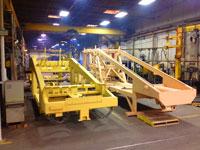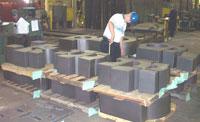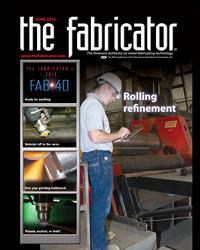Senior Editor
- FMA
- The Fabricator
- FABTECH
- Canadian Metalworking
Categories
- Additive Manufacturing
- Aluminum Welding
- Arc Welding
- Assembly and Joining
- Automation and Robotics
- Bending and Forming
- Consumables
- Cutting and Weld Prep
- Electric Vehicles
- En Español
- Finishing
- Hydroforming
- Laser Cutting
- Laser Welding
- Machining
- Manufacturing Software
- Materials Handling
- Metals/Materials
- Oxyfuel Cutting
- Plasma Cutting
- Power Tools
- Punching and Other Holemaking
- Roll Forming
- Safety
- Sawing
- Shearing
- Shop Management
- Testing and Measuring
- Tube and Pipe Fabrication
- Tube and Pipe Production
- Waterjet Cutting
Industry Directory
Webcasts
Podcasts
FAB 40
Advertise
Subscribe
Account Login
Search
How Genzink Steel redefined itself
Fabricator adopts new focus and disciplined manufacturing approach
- By Tim Heston
- June 3, 2013
- Article
- Shop Management

Figure 1: Genzink Steel’s custom fabrication services focus on complex, often large assemblies for mining, oil and gas, and other sectors.
In 1961 Don Genzink founded a small structural fabricator in Holland, Mich., serving local farmers as well as the furniture and automotive industries in west Michigan. That structural fabrication business expanded into miscellaneous metals, providing architectural metalwork for the region, and the company also acted as a service center, supplying materials for local manufacturers. From all this also evolved a custom fabrication business that focused on high-mix, low-volume production of plate metal parts and subassemblies.
Now known as Genzink Steel Supply and Welding, the company grew as a hybrid, organized into specific business units: part structural steel, part service center, part custom fabricator. Such a range of services ensured the customer base was diverse. When one sector softened, stronger sales from another sector would carry the business through.
Things changed with the new millennium. The shop experienced stiffer competition in structural fabrication, and the service center and custom fabrication operations were changing. “At the time we had a lot of talented people come into the business,” said John Maxson, Genzink’s chief operating officer. “We developed a more disciplined approach in our manufacturing techniques, and we put in controls on the front-end scheduling and planning to increase throughput and efficiencies.”
The improvement process didn’t happen overnight, smoothly, or without debate. Like anywhere else, at Genzink improvement took years and continues today unabated. The evolution entailed two elements, and in this fabricator’s case, one probably couldn’t have occurred without the other. First, Genzink defined its focus—that is, what it could best provide customers. Second, it formalized its quality, process improvement, and safety initiative. At Genzink this is all one effort; quality, process improvement, and safety are in effect three legs supporting one stool. And the most critical leg of all is safety.
Defining a Focus
For decades Genzink’s success hinged in part on its diverse capabilities to serve an array of customers, but starting in 2000 that model began to show cracks. Scheduling in the structural arena remained a juggling act, requiring the coordination of multiple parties. “In the world of structural steel, nothing is ever as planned or quoted at the onset of the project. Too many things outside of your control are brought into focus,” Maxson said. He added that often a project would be delayed and rescheduled, which in turn threw a wrench into Genzink’s other project schedules. “The competition for resources within our shop became really too much to bear.”
Although structural fabrication was an entirely different business, it still had served the manufacturer well over the decades. So to improve the situation, managers in 2006 decided to move the structural operation to another facility a three hours’ drive from Holland. Moving the structural business to another building would allow it to operate more independently, with separate schedules and proc-esses. The two sides also would no longer compete for time with shared resources. This worked for a time, but as sources conceded, this really was just a bandage covering up a deeper problem. Structural fabrication simply didn’t fit well with the rest of the company.
“We really tried to bridge the businesses,” Maxson recalled. “We were AISC-certified as well as ISO-certified. But we eventually realized we were serving too many masters. In 2008 we accepted the reality that the structural steel business segment wasn’t our focus.”
At the same time, custom fabrication
continued to take off as more OEMs called on Genzink for large, complex subassembly work. By 2008 the company made a dramatic decision, but one managers felt was the best path toward focusing the business. They exited structural fabrication.
Today the 160-employee firm again operates under one roof in Holland. At this 138,000-square-foot plant, the company separates its services into two categories. The first is the service center business. This entails plasma and oxyfuel cutting, as well as bending and machining of plate. The pieces also might be shotblasted and painted, depending on customer requirements. The second is custom fabrication, where welders and other technicians work to join pieces into assemblies. The service center processes parts and groups them in kits, ready for assembly or other downstream processing. Some kits go directly to external customers, and some go to the internal customer, Genzink’s custom fabrication, where welders assemble them into large assemblies (see Figures 1-3).

Figure 2: Since exiting the structural steel business in 2008, Genzink now operates out of one 138,000-square-foot facility in Holland, in rural western Michigan.
Like any high-product-mix operation, the service center is organized departmentally, all operating with the goal of assembling a kit of parts, packed on a pallet and sequenced to make assembly easier.
The custom fabrication side, which mainly involves welding, grinding, and other final assembly operations, is more fluid. The floor has three fabrication bays, but cells within each can be rearranged or removed as needed, changing depending on the product family and size of the workpiece. One day custom fabrication technicians may work on one assembly with hundreds of different components, and the next day they may tackle several smaller jobs, so welding cells are rearranged to suit.
The shop didn’t transform overnight. As Maxson explained, the company focused marketing efforts on customers with specific needs. For example, a customer may order various parts repeatedly, and Genzink’s kitting approach in its service center helps ease the customer’s assembly operations. Or customers might want to reduce or altogether eliminate in-house fabrication so they can focus on engineering, R&D, and final assembly. In this case, Genzink’s custom fabrication side is happy to help.
“Our customer focus changed from being a local or regional supplier to one that has national and international exposure,” Maxson said, “with a repetitive need for manufacturing services.” Several years ago a large OEM in the mining sector selected Genzink as one of three national suppliers to provide assemblies. Success in this area led to other mining-related jobs as well as customers in the oil and gas business.
Three Legs of a Stool
Cells in the custom fabrication bays need to be fluid for a reason. Some workpieces can span a good portion of the shop floor one week. The next week welders may work in individual areas, where they could be joining several small assemblies for different jobs. It’s a classic high-product-mix situation.
According to sources, Genzink puts safety and quality on equal footing, and work on the former often leads to improvements to the latter. As Sue Rollins, the fabricator’s quality and safety director, explained, safety and quality considerations come in on the ground floor of projects, during the quoting phase. And both quality and safety work in concert—hence Rollins’ job title.
“I have the luxury of being able to analyze both the safety and the quality side of the projects as they go through,” Rollins said. “They really are related disciplined practices. It ultimately comes down to saving lives and saving money.”
When Rollins started her job four years ago, Genzink had a safety committee, but people lacked formal training in risk assessment—specifically, how to look at any situation with the safety risks in mind.
“With everybody having that core training now, people now realize that the first thing we need to evaluate is the safety side in everything we do, everything from job releasing to completion of the job,” Rollins said.
She works with an outside firm that helps Genzink assess risk, be it for a certain job or general procedure. If a large assembly requires a welder or other technician to work in awkward positions, safety considerations are brought up in the quoting stage. Questions are asked early, problems are resolved, and often quality is improved, usually because of ergonomic changes. Are fixtures needed for easier welder access? What about part movement? If it’s too heavy, does it require special rigging?

Figure 3: Genzink’s service center side of the business focuses on cutting, bending, and coating of heavy plate. Its oxyfuel cutting systems sometimes cut plate more than 10 inches thick.
To assemble these products often requires welders to work in confined spaces. So from the get-go, Rollins and her team ensure that employees who must work in such a space have the respiratory tools they need, including local fume collection when possible and personal respirators. Air quality is monitored continuously, and there’s a dry practice run before welding starts. Outside firms are hired to perform all monitoring and rescues, if needed.
“All of this is evaluated at the time of quoting, and is quoted into the job,” Rollins said. “We identify if the project will create a confined space, identify the qualified people we have and those that should be trained, and the cost. All of this is determined ahead of time.”
Every month a 15-person safety committee conducts safety audits. Working in teams of two, they observe and record behavior and ensure everyone is using proper safeguarding and personal protective equipment (PPE). They look at previous months to check that corrections made in prior months are still in effect, be it a machine guard, proper use of PPE, or anything else. The team also conducts studies in ergonomics, which dovetails into continuous improvement. Make a person more comfortable on the job, and he or she will probably be more productive.
Rollins emphasized that the company does not incentivize people to reach a goal with safety statistics—say, a bonus for going so many days without a lost-time incident or near miss. “We encourage reporting, and we do a lot of training based on those reports,” said Rollins, “especially a near miss, where we do an investigation and get everyone involved.” If workers don’t report unsafe behavior, she said, it becomes more difficult to improve.
The safety environment at Genzink wasn’t always like this. Before 2007 Maxson called Genzink’s safety regimen “old school,” based primarily on the experience of those working on a particular job. “The disciplined methodology we use today is a far cry from the way we looked at in years prior,” he said.
Genzink has a sophisticated customer base with stringent quality requirements, including product traceability and process documentation. The company has ISO 9001:2008 certification. The company employs four certified welding inspectors (CWIs) and three degreed welding engineers.
If Genzink didn’t have these proc-esses in place, it wouldn’t have some of the accounts it enjoys. And the same applies to safety, because some of Genzink’s major customers are demanding many safety initiatives, particularly in the oil and gas arena. In fact, Maxson said he has met with Genzink’s customers, who in turn have said safety initiatives have been driven by their ultimate customer—the multinational oil, gas, and mining companies. “We’ve seen the results of unsafe acts in the newspapers,” he said, “and the expenses behind them.”
“The majority of our customers evaluate our safety system before they evaluate our quality system,” Rollins said. “That means we won’t have people missing time from work, and we’ll have the qualified people on the job every day.”
The Three Legs at Work
In the past workers in custom fabrication used ladders to access certain areas of large assemblies. They sometimes had to contort themselves to access assembly points. Today they use mobile step platforms. Not only are they easier to climb, but workers can take more tools with them, and they gain better access to the assembly points. The result: More tools are at the point of use, which means welders and assemblers are more efficient. They’re safer and more comfortable. This simple initiative incorporated all three legs of the stool: safety, quality, and process improvement.
The fabricator had good timing on its side, considering it bowed out of the structural business a year before the bottom fell out in 2009. Most of Genzink’s customers during the recession experienced dramatic volume reductions, but not all of them. The underground mining and, to some degree, the surface mining stayed relatively strong through the financial crisis. Still, the recession did hit Genzink significantly, albeit a bit later than most.
Maxson said that revenues dropped by more than 40 percent, and many workers were laid off. At the recession’s worst, Genzink employed about 110, down from about 250 several years before when the firm served both structural and custom fabrication markets.
Employees experienced pay cuts, elimination of their 401(k) match, and similar belt-tightening hardships all too common several years ago. It took about a year and a half before the cuts in pay and the 401(k) match were lifted. “We were hit very hard,” Maxson said, “and frankly, if we had not made that transition when we did, and the mining was not a piece of our business, I’m not sure we’d still be around today.”
Moving forward, managers expect an uncertain ride going into late 2013 and early 2014. They project revenues to be $32 million this year, $2 million more than last year. The fabricator’s mining work has softened since last year, but new oil and gas customers have picked up the slack. Managers hope the three legs—safety, quality, and process improvement—along with a well-focused foundation of large-part and assembly fabrication, will help the business be prepared for whatever lies ahead.
About the Author

Tim Heston
2135 Point Blvd
Elgin, IL 60123
815-381-1314
Tim Heston, The Fabricator's senior editor, has covered the metal fabrication industry since 1998, starting his career at the American Welding Society's Welding Journal. Since then he has covered the full range of metal fabrication processes, from stamping, bending, and cutting to grinding and polishing. He joined The Fabricator's staff in October 2007.
Related Companies
subscribe now

The Fabricator is North America's leading magazine for the metal forming and fabricating industry. The magazine delivers the news, technical articles, and case histories that enable fabricators to do their jobs more efficiently. The Fabricator has served the industry since 1970.
start your free subscription- Stay connected from anywhere

Easily access valuable industry resources now with full access to the digital edition of The Fabricator.

Easily access valuable industry resources now with full access to the digital edition of The Welder.

Easily access valuable industry resources now with full access to the digital edition of The Tube and Pipe Journal.
- Podcasting
- Podcast:
- The Fabricator Podcast
- Published:
- 04/16/2024
- Running Time:
- 63:29
In this episode of The Fabricator Podcast, Caleb Chamberlain, co-founder and CEO of OSH Cut, discusses his company’s...
- Industry Events
16th Annual Safety Conference
- April 30 - May 1, 2024
- Elgin,
Pipe and Tube Conference
- May 21 - 22, 2024
- Omaha, NE
World-Class Roll Forming Workshop
- June 5 - 6, 2024
- Louisville, KY
Advanced Laser Application Workshop
- June 25 - 27, 2024
- Novi, MI































